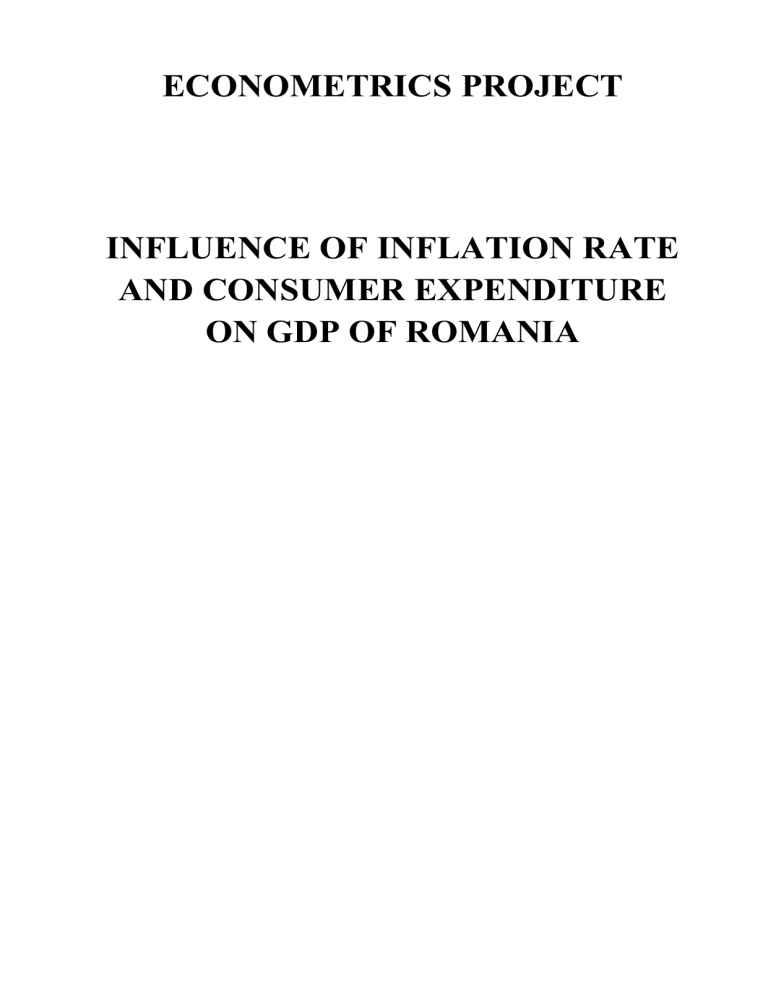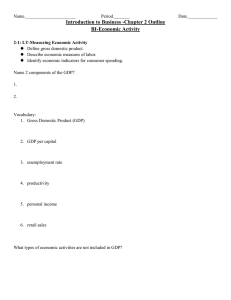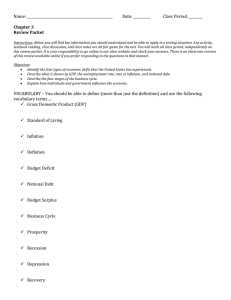
ECONOMETRICS PROJECT INFLUENCE OF INFLATION RATE AND CONSUMER EXPENDITURE ON GDP OF ROMANIA I. Data The data is collected over a period of 15 years, starting with 2002 and up to and including 2016. The dependent variable (y) is GDP and the independent variables xl and x2 are the inflation rate and the average monthly income per household Source: National Institute of Statistics I.1. Graph evolution GDP / years (dependency variable): Chart 1: Year-on-year GDP evolution - Graph tablework I.2. Graph inflation rate evolution / years (independent variable): Chart 2: Inflation Rate / Year - Graph Table Processing I.3. Chart average monthly income per household / years (independent variable): Chart 3: Monthly average revenue per year - Graph tablework II. Motivation to choose the theme: Through this project we aim to analyze the link between the gross domestic product at the level of Romania taking into account the monthly average income per household (at the level of the year) and the inflation rate. We chose this theme to highlight the influence of wage growth over the past few years on GDP and also the reverse relationship between GDP and the inflation rate (the higher the GDP is, the lower the inflation rate). III. Analysis of the economic evolution between the three variables using the correlation coefficient and the Scatter graph: The intensity of the link between inflation rate and GDP Inflation rate on GDP The correlation coefficient is = -0.889, the link between inflation rate and GDP is reversed, when inflation falls, GDP is rising. Intensity of the link between monthly average income per household and GDP Average monthly GDP revenue The correlation coefficient is = 0.979, the link between inflation rate and GDP is straightforward, so when the average monthly income per household grows, GDP rises. IV. Simple regression yi = a + bxi The estimated regression line is y = -52117.54 + 250.566 * x1 The default error is: 30803.41592 and 14.43101158 Statistics t: -1.6919 and 17.36 Probability: 0.11 and 2.24 The multiple correlation coefficient R = 0.979 and shows that there is a direct and strong link between the two variables. The coefficient of determination R2 = 0.958 shows that GDP is influenced by 95.8%, which means that the average monthly income is representative of GDP. Interpretation of parameters: The value of the coefficient b = 250.566 measures the slope of the regression line and shows that when x increases by one unit, the GDP will increase by 250.566. The value a = -52117.54 shows the level of GDP when the monthly average revenue is 0. Testing the validity of the model Hypotheses: Ho: The model is not valid (MSR = MSE) Hi: The model is valid (MSR> MSE) According to the ANOVA F test calculated = 301 and F table = F 0.05; We dismiss HO, we accept H1 (Fcalculat> Ft) Waste Analysis: Se = standard error Ft = t 2; 13 = t0.025,12 = 2.160 Se = 42090 The range [-Ft * SE; Ft * SE] Interval [-90914.4; 90914.4] Waste The points on the graph fall between the two boundaries of the range (marked with blue lines) so as to respect the normality assumptions of the errors, the errors from a normal distribution. V. Multiple Regression: Y = b0 + b1x1 + b2x2 + E Date: bo = 44038 (GDP value when x1 and x2 are 0) b1 = -47447 b2 = 219 =>y = x1 + 219 * 44038-4747 * x2 The value of the coefficient bi = -4747 <0, shows that an increase in inflation with one unit leads to a decrease in GDP by 4747 which shows that between GDP and inflation there is an indirect link. The value of the coefficient b2 = 219 shows that an increase of the average monthly income per household with one unit leads to the increase of the GDP by 219 thousand lei. The coefficient of determination R2 = 0.96 shows that 96% of GDP is influenced by the two exogenous variables. The coefficient R = 0.98 shows that there is a strong linear link between the three variables. Testing the validity of the model: Ho: Bi = 0 H: Bi <> 0 T state b1 = - 1.237 P value = 0.24> a = 0.05 => accept HO, which means that the inflation rate does not have a significant influence on GDP T state b2 = 7.6 P value = 0.00 <a> 0.05 = which means that the average monthly income has a significant influence on GDP Waste Analysis: Durbin – Watson: d1 = 0.95 d2 = 1.54 DW = 0.70 and falls within the range [O; d1], that is, [0; 0.95] which means a positive autocorrelation of errors. VI. Conclusions Between the gross domestic product and the average monthly income per household (in 20022016), there is a direct relationship. There is also a reverse relationship between inflation and GDP. It can be noticed that during the analyzed period, the inflation rate decreased simultaneously with the increase of the average household income stimulating the consumption of the population, which represented an effective way of GDP growth. When the inflation rate decreases and the purchasing power increases, the individual tends to buy more. By using linear linear regression, we can see the existence of a strong link between Gross Domestic Product and the inflated rate of inflation. During the analyzed period, it is noted that in the years 2002 - 2006 the inflation rate peaked (relative to the analyzed period) having a negative impact on GDP by reducing it.





